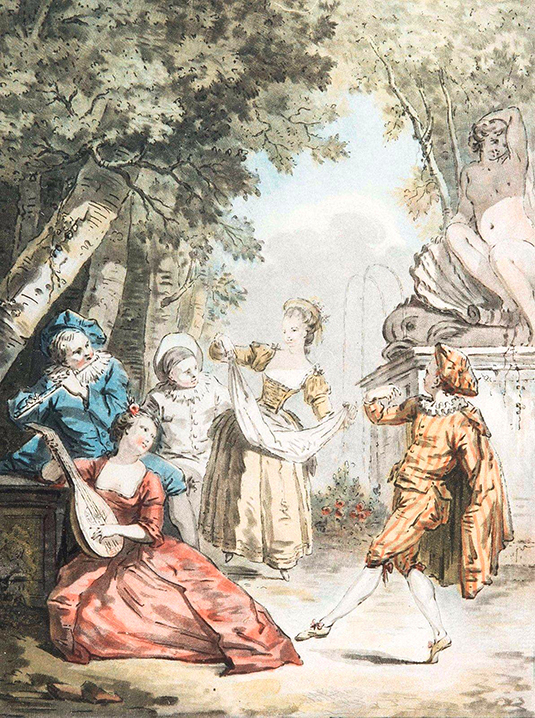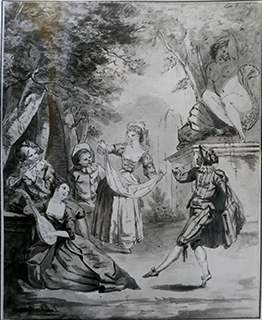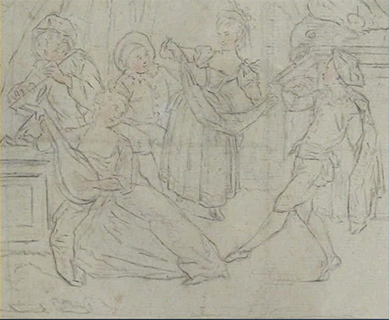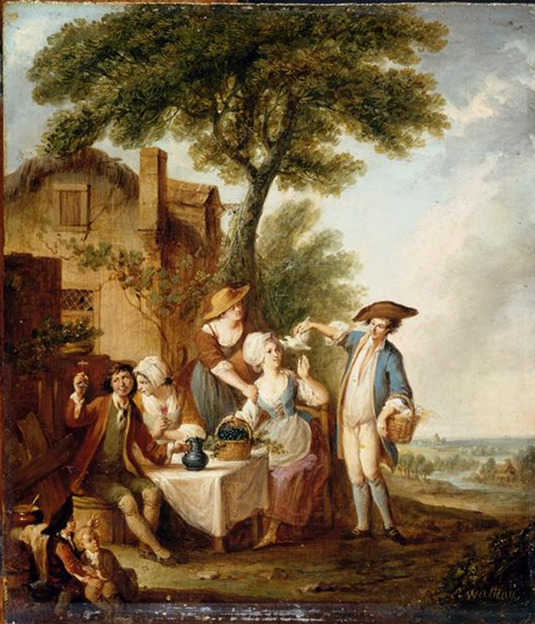
- Home Page
- Accepted
Paintings & Copies - Doubtful
Attributions - Doubtful Textual References
- Alternative
Titles - Collectors &
Museums - Bibliography
- Search Abecedario
- Watteau &
His Circle
X. Les Comédiens comiques
Entered May 2020; revised July 2021

Whereabouts unknown
Medium unknown
Measurements unknown
ALTERNATIVE TITLES
Flute Player, Woman Playing a Lute, Pierrot, and Dancing Couples
RELATED PRINTS

Jean François Janinet after “Watteau,” Les Comédiens comiques, color mezzotint, 1774.
This composition and its pendant, Le Rendé-vous comique, were executed as mezzotint engravings by Jean François Janinet. The legend below declares at the left, “Wattaeux pix.” The name of the engraver is not given but the text below announces, “A Paris chez Janinet, Rue St Jacques. . . . ” The pendant print is dated 1774, and it should be presumed that Les Comédiens comiques was executed at the same time.
SELECT BIBLIOGRAPHY
Goncourt, Catalogue raisonné (1875), cat. 79.
Dacier, Vuaflart, and Hérold, Jean de Jullienne et les graveurs (1921-29), cat. 300.
Adhémar, Watteau (1950), cat. 306.
Macchia and Montagni, L’opera completa di Watteau (1968), cat. 2o -CC.
Roux, Fonds français, (1973), 12: 9.
RELATED DRAWINGS
There are two compositional drawings related to Les Comédiens comiques, but neither is by Antoine Watteau.

Anonymous after Jean François Janinet, Les Comédiens comiques, ink and watercolor, 19.9 x 16 cm. Whereabouts unknown.
An ink and watercolor drawing attributed to Louis Joseph Watteau (1731-1798), Antoine Watteau’s nephew, corresponds to this composition. It appeared at auction in Monte Carlo, Sotheby’s, December 2, 1989, lot 205, together with the second drawing of the pendant, Le Rendé-vous comique. The attribution to Louis Joseph Watteau might seem arbitrary but, in fact, Watteau’s nephew may have been the artist responsible for the composition engraved by Janinet. The composition is almost identical to Janinet’s print. There are only the slightest differences between the two: the folds in the lutenist’s skirt, the amount of space between that skirt and the foot of the male dancer, and the delineation of the statue’s breasts and legs. Also the composition is extended to the right, to show more of the lower portion of the statue and the dolphin’s tail. A question which remains is whether this study and its pendant were made in preparation for the prints or were made after them. A second and equally pertinent question is whether Janinet was copying an actual oil painting or, rather, this ink and watercolor drawing. Both situations would allow the term "Watteau pinx." The latter seems the more likely.

Anonymous artist after Jean François Janinet, Les Comédiens comiques, black and red chalk, 11.8 x14 cm. Whereabouts unknown.
A second drawing appeared at auction a few years ago, offered by Galartis, Crissier, Switzerland, October 25, 2015, lot 143. It was attributed to the French School, “dans le goût de Watteau,” but without any reference to Janinet and Les Comédiens comiques. This rudimentary outline sketch copies the print without any significant changes.
REMARKS
Edmond de Goncourt was the first to include this print and its pendant in his catalogue raisonné of Watteau’s oeuvre. He accepted the rather trite title engraved below, which is still employed today.
Both of Janinet’s prints are captioned, “Watteau pinx.” but this claim does not inspire confidence. The two works have the same compositional formula: an upright vertical, with the figures pressed into the immediate foreground and occupying only the bottom half of the print. Dominating both works is, at the side, a statue posed on a high pedestal. The vertical format and the elevated statue are elements that do not figure in Watteau’s fêtes galantes but they do appear in those of his followers. What were Janinet’s models? Were they actual but falsely attributed paintings, executed c. 1720-40, or were they more recent design? The latter seems more probable. The figures are more aligned with the age and aesthetic of Jean Frédéric Schall and Fragonard, rather than the age of Watteau. And, indeed, one is dated 1774.
When Dacier, Vuaflart, and Hérold published these prints they noted that the attribution to Watteau “paraît sujette à caution.” Likewise, Adhémar listed these compositions among doubtful attributions, and Macchia and Montagni also included them in a supplementary section devoted to doubtful works. The attribution to Watteau is more than dubious, it is spurious.

Louis Joseph Watteau, La Jolie colombe, oil on panel, 29.3 x 25.2 cm. Valenciennes, Musée des beaux-arts.
Dacier, Vuaflart, and Hérold noted that the space before “Wattaeux” on the print for Le Rendé-vous comique shows signs of the engraving plate having been effaced just there, as though the artist’s given name had been changed. This is particularly germane because Michèle Hébert and Yves Sjöberg in their entry in the Fonds français have proposed that the artist responsible for the composition was not Antoine Watteau but his nephew, Louis Joseph Watteau (1731-1798). This is a credible resolution of the issue.